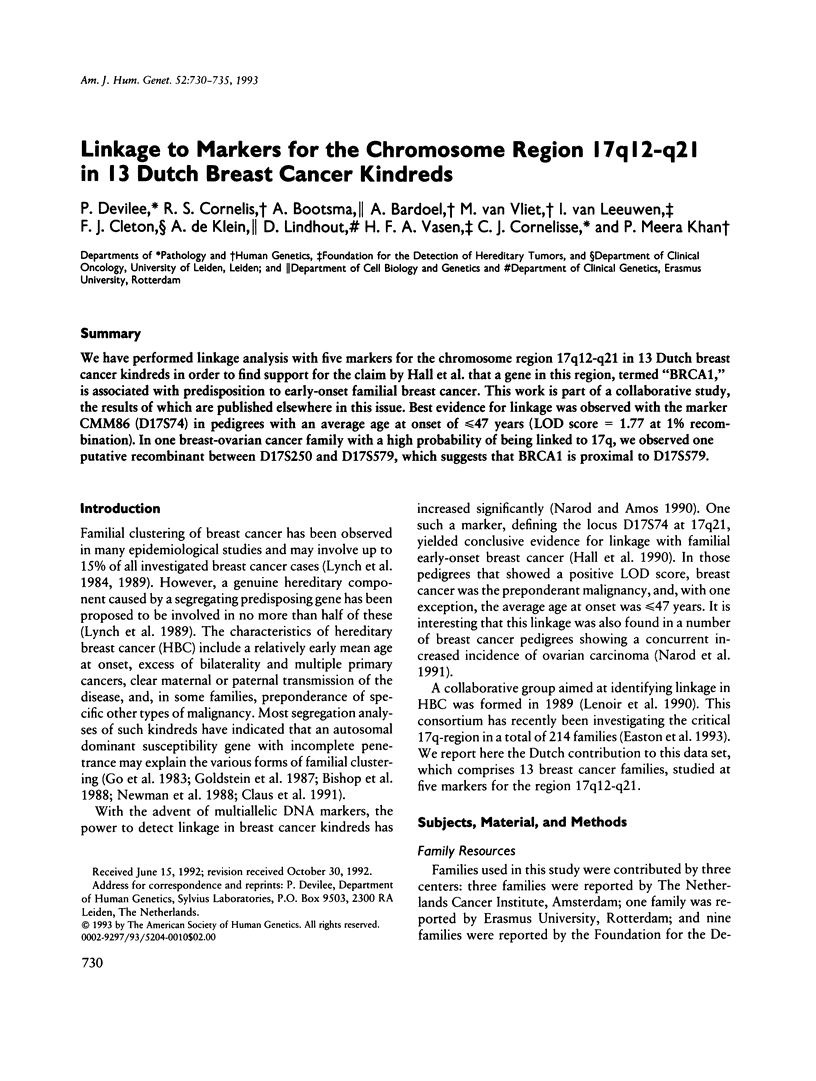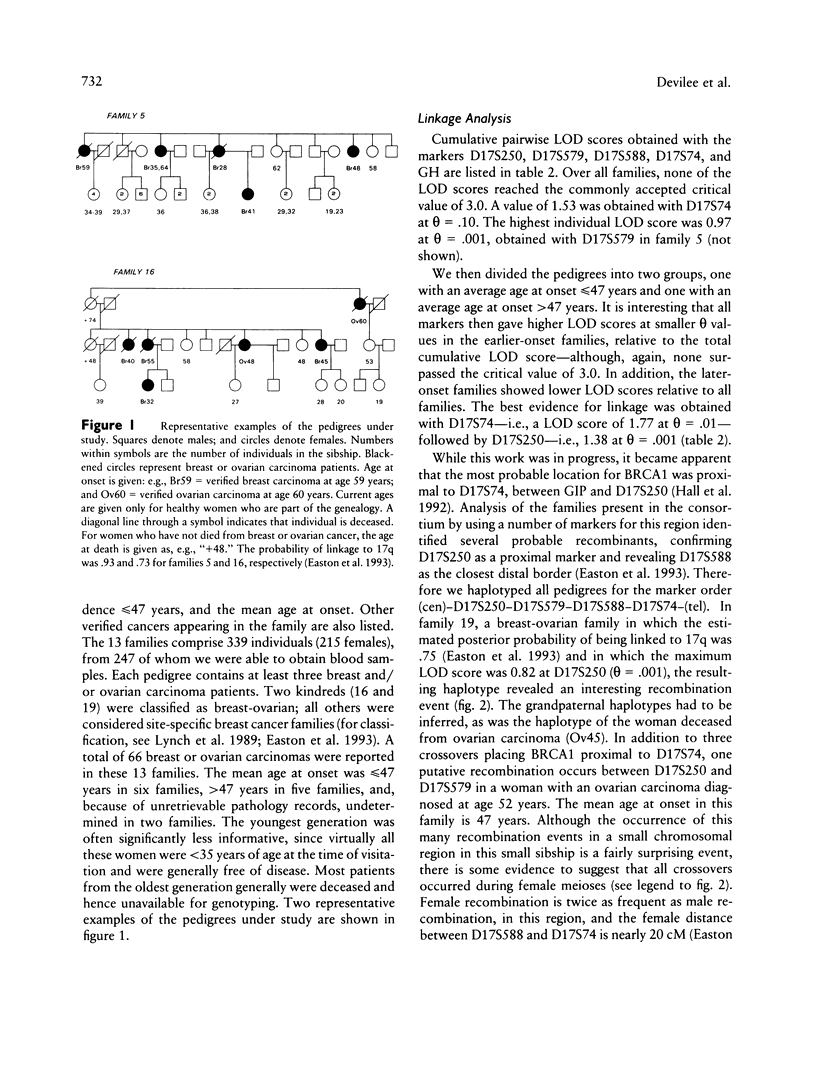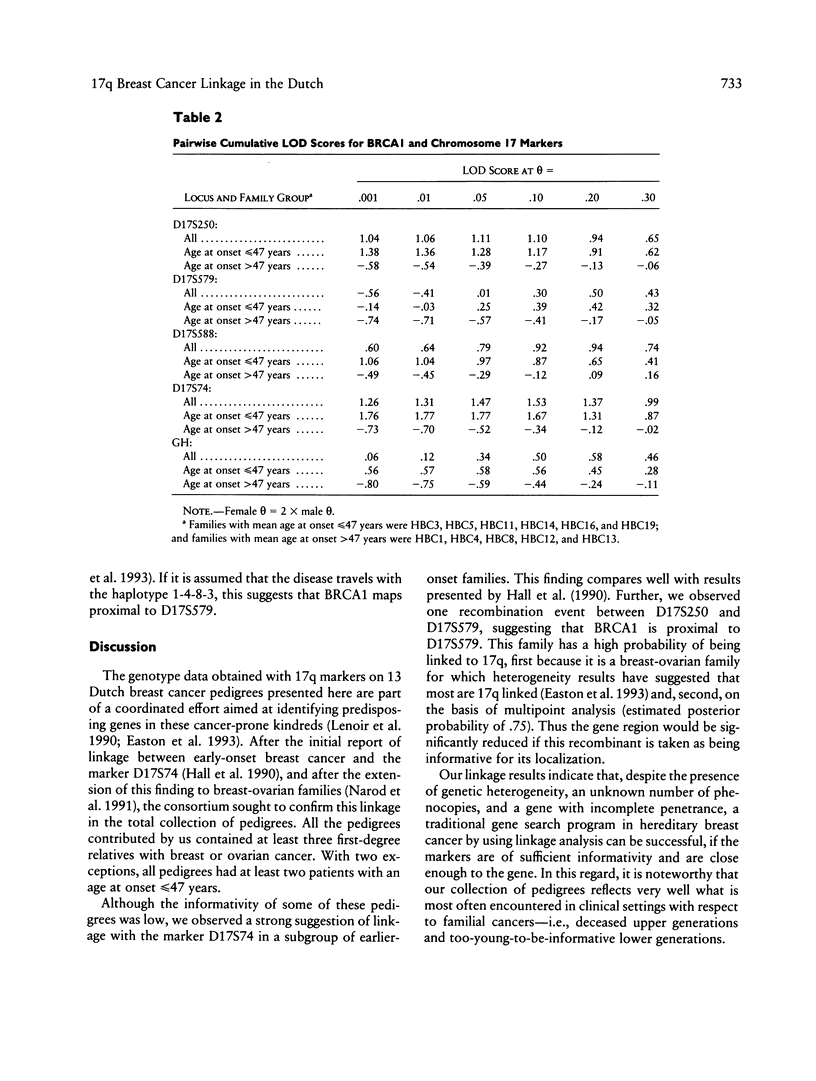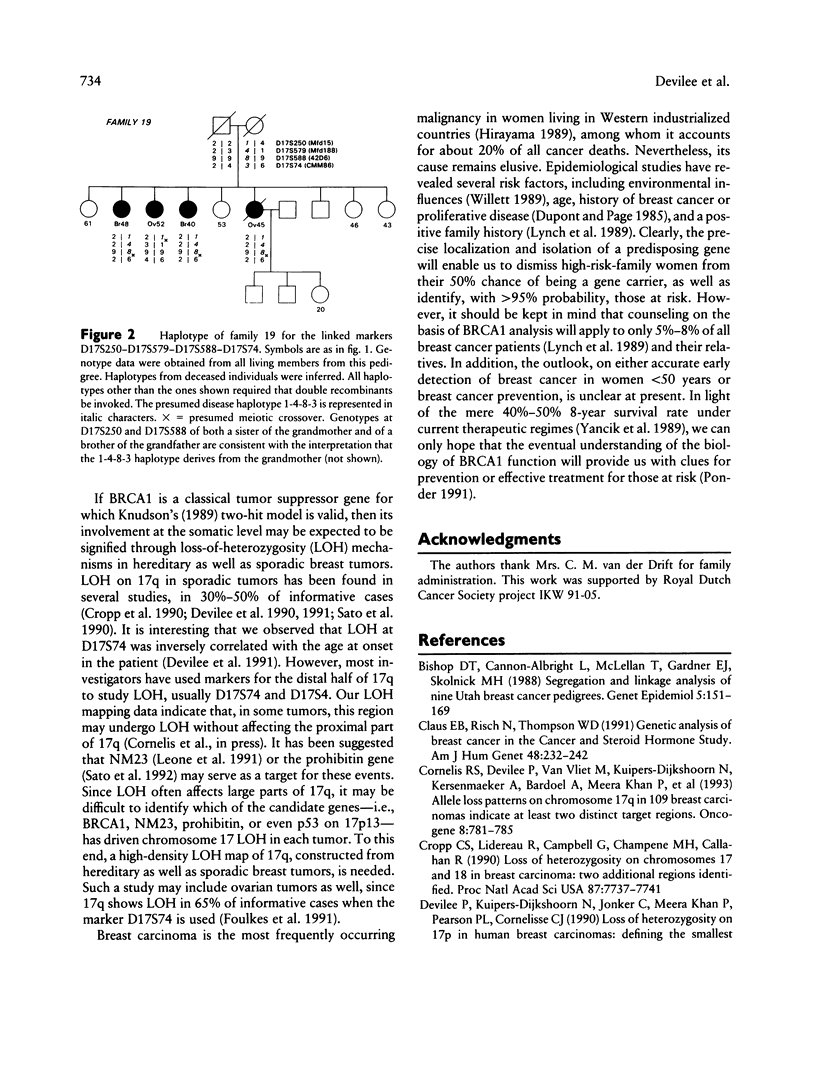Abstract
We have performed linkage analysis with five markers for the chromosome region 17q12-q21 in 13 Dutch breast cancer kindreds in order to find support for the claim by Hall et al. that a gene in this region, termed “BRCA1,” is associated with predisposition to early-onset familial breast cancer. This work is part of a collaborative study, the results of which are published elsewhere in this issue. Best evidence for linkage was observed with the marker CMM86 (D17S74) in pedigrees with an average age at onset of ≤47 years (LOD score = 1.77 at 1% recombination). In one breast-ovarian cancer family with a high probability of being linked to 17q, we observed one putative recombinant between D17S250 and D17S579, which suggests that BRCA1 is proximal to D17S579.
Full text
PDF





Selected References
These references are in PubMed. This may not be the complete list of references from this article.
- Bishop D. T., Cannon-Albright L., McLellan T., Gardner E. J., Skolnick M. H. Segregation and linkage analysis of nine Utah breast cancer pedigrees. Genet Epidemiol. 1988;5(3):151–169. doi: 10.1002/gepi.1370050303. [DOI] [PubMed] [Google Scholar]
- Claus E. B., Risch N., Thompson W. D. Genetic analysis of breast cancer in the cancer and steroid hormone study. Am J Hum Genet. 1991 Feb;48(2):232–242. [PMC free article] [PubMed] [Google Scholar]
- Cornelis R. S., Devilee P., van Vliet M., Kuipers-Dijkshoorn N., Kersenmaeker A., Bardoel A., Khan P. M., Cornelisse C. J. Allele loss patterns on chromosome 17q in 109 breast carcinomas indicate at least two distinct target regions. Oncogene. 1993 Mar;8(3):781–785. [PubMed] [Google Scholar]
- Cropp C. S., Lidereau R., Campbell G., Champene M. H., Callahan R. Loss of heterozygosity on chromosomes 17 and 18 in breast carcinoma: two additional regions identified. Proc Natl Acad Sci U S A. 1990 Oct;87(19):7737–7741. doi: 10.1073/pnas.87.19.7737. [DOI] [PMC free article] [PubMed] [Google Scholar]
- Devilee P., Cornelisse C. J., Kuipers-Dijkshoorn N., Jonker C., Pearson P. L. Loss of heterozygosity on 17p in human breast carcinomas: defining the smallest common region of deletion. Cytogenet Cell Genet. 1990;53(1):52–54. doi: 10.1159/000132893. [DOI] [PubMed] [Google Scholar]
- Devilee P., van Vliet M., van Sloun P., Kuipers Dijkshoorn N., Hermans J., Pearson P. L., Cornelisse C. J. Allelotype of human breast carcinoma: a second major site for loss of heterozygosity is on chromosome 6q. Oncogene. 1991 Sep;6(9):1705–1711. [PubMed] [Google Scholar]
- Devilee P., van den Broek M., Kuipers-Dijkshoorn N., Kolluri R., Khan P. M., Pearson P. L., Cornelisse C. J. At least four different chromosomal regions are involved in loss of heterozygosity in human breast carcinoma. Genomics. 1989 Oct;5(3):554–560. doi: 10.1016/0888-7543(89)90023-2. [DOI] [PubMed] [Google Scholar]
- Dupont W. D., Page D. L. Risk factors for breast cancer in women with proliferative breast disease. N Engl J Med. 1985 Jan 17;312(3):146–151. doi: 10.1056/NEJM198501173120303. [DOI] [PubMed] [Google Scholar]
- Easton D. F., Bishop D. T., Ford D., Crockford G. P. Genetic linkage analysis in familial breast and ovarian cancer: results from 214 families. The Breast Cancer Linkage Consortium. Am J Hum Genet. 1993 Apr;52(4):678–701. [PMC free article] [PubMed] [Google Scholar]
- Foulkes W., Black D., Solomon E., Trowsdale J. Allele loss on chromosome 17q in sporadic ovarian cancer. Lancet. 1991 Aug 17;338(8764):444–445. doi: 10.1016/0140-6736(91)91065-3. [DOI] [PubMed] [Google Scholar]
- Go R. C., King M. C., Bailey-Wilson J., Elston R. C., Lynch H. T. Genetic epidemiology of breast cancer and associated cancers in high-risk families. I. Segregation analysis. J Natl Cancer Inst. 1983 Sep;71(3):455–461. [PubMed] [Google Scholar]
- Goldstein A. M., Haile R. W., Marazita M. L., Paganini-Hill A. A genetic epidemiologic investigation of breast cancer in families with bilateral breast cancer. I. Segregation analysis. J Natl Cancer Inst. 1987 May;78(5):911–918. [PubMed] [Google Scholar]
- Hall J. M., Friedman L., Guenther C., Lee M. K., Weber J. L., Black D. M., King M. C. Closing in on a breast cancer gene on chromosome 17q. Am J Hum Genet. 1992 Jun;50(6):1235–1242. [PMC free article] [PubMed] [Google Scholar]
- Hall J. M., Lee M. K., Newman B., Morrow J. E., Anderson L. A., Huey B., King M. C. Linkage of early-onset familial breast cancer to chromosome 17q21. Science. 1990 Dec 21;250(4988):1684–1689. doi: 10.1126/science.2270482. [DOI] [PubMed] [Google Scholar]
- Knudson A. G., Jr The ninth Gordon Hamilton-Fairley memorial lecture. Hereditary cancers: clues to mechanisms of carcinogenesis. Br J Cancer. 1989 May;59(5):661–666. doi: 10.1038/bjc.1989.137. [DOI] [PMC free article] [PubMed] [Google Scholar]
- Lenoir G. M., Narod S. A., Ponder B. A. Workshop on linkage studies of hereditary breast cancer. Cancer Res. 1990 Jul 15;50(14):4448–4449. [PubMed] [Google Scholar]
- Leone A., McBride O. W., Weston A., Wang M. G., Anglard P., Cropp C. S., Goepel J. R., Lidereau R., Callahan R., Linehan W. M. Somatic allelic deletion of nm23 in human cancer. Cancer Res. 1991 May 1;51(9):2490–2493. [PubMed] [Google Scholar]
- Lynch H. T., Albano W. A., Heieck J. J., Mulcahy G. M., Lynch J. F., Layton M. A., Danes B. S. Genetics, biomarkers, and control of breast cancer: a review. Cancer Genet Cytogenet. 1984 Sep;13(1):43–92. doi: 10.1016/0165-4608(84)90087-6. [DOI] [PubMed] [Google Scholar]
- Miller S. A., Dykes D. D., Polesky H. F. A simple salting out procedure for extracting DNA from human nucleated cells. Nucleic Acids Res. 1988 Feb 11;16(3):1215–1215. doi: 10.1093/nar/16.3.1215. [DOI] [PMC free article] [PubMed] [Google Scholar]
- Narod S. A., Amos C. Estimating the power of linkage analysis in hereditary breast cancer. Am J Hum Genet. 1990 Feb;46(2):266–272. [PMC free article] [PubMed] [Google Scholar]
- Narod S. A., Feunteun J., Lynch H. T., Watson P., Conway T., Lynch J., Lenoir G. M. Familial breast-ovarian cancer locus on chromosome 17q12-q23. Lancet. 1991 Jul 13;338(8759):82–83. doi: 10.1016/0140-6736(91)90076-2. [DOI] [PubMed] [Google Scholar]
- Newman B., Austin M. A., Lee M., King M. C. Inheritance of human breast cancer: evidence for autosomal dominant transmission in high-risk families. Proc Natl Acad Sci U S A. 1988 May;85(9):3044–3048. doi: 10.1073/pnas.85.9.3044. [DOI] [PMC free article] [PubMed] [Google Scholar]
- Polymeropoulos M. H., Rath D. S., Xiao H., Merril C. R. A simple sequence repeat polymorphism at the human growth hormone locus. Nucleic Acids Res. 1991 Feb 11;19(3):689–689. doi: 10.1093/nar/19.3.689. [DOI] [PMC free article] [PubMed] [Google Scholar]
- Ponder B. A. Genetic predisposition to cancer. Br J Cancer. 1991 Aug;64(2):203–204. doi: 10.1038/bjc.1991.275. [DOI] [PMC free article] [PubMed] [Google Scholar]
- Sato T., Saito H., Swensen J., Olifant A., Wood C., Danner D., Sakamoto T., Takita K., Kasumi F., Miki Y. The human prohibitin gene located on chromosome 17q21 is mutated in sporadic breast cancer. Cancer Res. 1992 Mar 15;52(6):1643–1646. [PubMed] [Google Scholar]
- Sato T., Tanigami A., Yamakawa K., Akiyama F., Kasumi F., Sakamoto G., Nakamura Y. Allelotype of breast cancer: cumulative allele losses promote tumor progression in primary breast cancer. Cancer Res. 1990 Nov 15;50(22):7184–7189. [PubMed] [Google Scholar]
- Weber J. L., Kwitek A. E., May P. E., Wallace M. R., Collins F. S., Ledbetter D. H. Dinucleotide repeat polymorphisms at the D17S250 and D17S261 loci. Nucleic Acids Res. 1990 Aug 11;18(15):4640–4640. [PMC free article] [PubMed] [Google Scholar]
- Weber J. L., May P. E. Abundant class of human DNA polymorphisms which can be typed using the polymerase chain reaction. Am J Hum Genet. 1989 Mar;44(3):388–396. [PMC free article] [PubMed] [Google Scholar]
- Willett W. The search for the causes of breast and colon cancer. Nature. 1989 Mar 30;338(6214):389–394. doi: 10.1038/338389a0. [DOI] [PubMed] [Google Scholar]
- Yancik R., Ries L. G., Yates J. W. Breast cancer in aging women. A population-based study of contrasts in stage, surgery, and survival. Cancer. 1989 Mar 1;63(5):976–981. doi: 10.1002/1097-0142(19890301)63:5<976::aid-cncr2820630532>3.0.co;2-a. [DOI] [PubMed] [Google Scholar]


